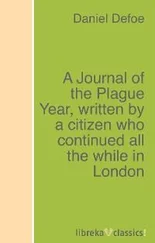Даниэль Дефо - History of the Plague in London
Здесь есть возможность читать онлайн «Даниэль Дефо - History of the Plague in London» весь текст электронной книги совершенно бесплатно (целиком полную версию без сокращений). В некоторых случаях можно слушать аудио, скачать через торрент в формате fb2 и присутствует краткое содержание. Год выпуска: 2014, Издательство: epubBooks Classics, Жанр: Историческая проза, на английском языке. Описание произведения, (предисловие) а так же отзывы посетителей доступны на портале библиотеки ЛибКат.
- Название:History of the Plague in London
- Автор:
- Издательство:epubBooks Classics
- Жанр:
- Год:2014
- ISBN:нет данных
- Рейтинг книги:4 / 5. Голосов: 1
-
Избранное:Добавить в избранное
- Отзывы:
-
Ваша оценка:
- 80
- 1
- 2
- 3
- 4
- 5
History of the Plague in London: краткое содержание, описание и аннотация
Предлагаем к чтению аннотацию, описание, краткое содержание или предисловие (зависит от того, что написал сам автор книги «History of the Plague in London»). Если вы не нашли необходимую информацию о книге — напишите в комментариях, мы постараемся отыскать её.
History of the Plague in London — читать онлайн бесплатно полную книгу (весь текст) целиком
Ниже представлен текст книги, разбитый по страницам. Система сохранения места последней прочитанной страницы, позволяет с удобством читать онлайн бесплатно книгу «History of the Plague in London», без необходимости каждый раз заново искать на чём Вы остановились. Поставьте закладку, и сможете в любой момент перейти на страницу, на которой закончили чтение.
Интервал:
Закладка:
My friend Dr. Heath was of opinion that it might be known by the smell of their breath; but then, as he said, who durst smell to that breath for his information, since to know it he must draw the stench of the plague up into his own brain in order to distinguish the smell? I have heard it was the opinion of others that it might be distinguished by the party's breathing upon a piece of glass, where, the breath condensing, there might living creatures be seen by a microscope, of strange, monstrous, and frightful shapes, such as dragons, snakes, serpents, and devils, horrible to behold. But this I very much question the truth of, and we had no microscopes at that time, as I remember, to make the experiment with. [273] Defoe's ignorance of microscopes was not shared by Robert Hooke, whose Micrographia (published in 1664) records numerous discoveries made with that instrument.
It was the opinion, also, of another learned man that the breath of such a person would poison and instantly kill a bird, not only a small bird, but even a cock or hen; and that, if it did not immediately kill the latter, it would cause them to be roupy, [274] Roup is a kind of chicken's catarrh.
as they call it; particularly that, if they had laid any eggs at that time, they would be all rotten. But those are opinions which I never found supported by any experiments, or heard of others that had seen it, [275] Them, i.e., such experiments.
so I leave them as I find them, only with this remark, namely, that I think the probabilities are very strong for them.
Some have proposed that such persons should breathe hard upon warm water, and that they would leave an unusual scum upon it, or upon several other things, especially such as are of a glutinous substance, and are apt to receive a scum, and support it.
But, from the whole, I found that the nature of this contagion was such that it was impossible to discover it at all, or to prevent it spreading from one to another by any human skill.
Here was indeed one difficulty, which I could never thoroughly get over to this time, and which there is but one way of answering that I know of, and it is this; viz., the first person that died of the plague was on December 20th, or thereabouts, 1664, and in or about Longacre: whence the first person had the infection was generally said to be from a parcel of silks imported from Holland, and first opened in that house.
But after this we heard no more of any person dying of the plague, or of the distemper being in that place, till the 9th of February, which was about seven weeks after, and then one more was buried out of the same house. Then it was hushed, and we were perfectly easy as to the public for a great while; for there were no more entered in the weekly bill to be dead of the plague till the 22d of April, when there were two more buried, not out of the same house, but out of the same street; and, as near as I can remember, it was out of the next house to the first. This was nine weeks asunder; and after this we had no more till a fortnight, and then it broke out in several streets, and spread every way. Now, the question seems to lie thus: Where lay the seeds of the infection all this while? how came it to stop so long, and not stop any longer? Either the distemper did not come immediately by contagion from body to body, or, if it did, then a body may be capable to continue infected, without the disease discovering itself, many days, nay, weeks together; even not a quarantine [276] From the Latin quadraginta ("forty").
of days only, but a soixantine, [277] From the Latin sexaginta ("sixty").
—not only forty days, but sixty days, or longer.
It is true there was, as I observed at first, and is well known to many yet living, a very cold winter and a long frost, which continued three months; and this, the doctors say, might check the infection. But then the learned must allow me to say, that if, according to their notion, the disease was, as I may say, only frozen up, it would, like a frozen river, have returned to its usual force and current when it thawed; whereas the principal recess of this infection, which was from February to April, was after the frost was broken and the weather mild and warm.
But there is another way of solving all this difficulty, which I think my own remembrance of the thing will supply; and that is, the fact is not granted, namely, that there died none in those long intervals, viz., from the 20th of December to the 9th of February, and from thence to the 22d of April. The weekly bills are the only evidence on the other side, and those bills were not of credit enough, at least with me, to support an hypothesis, or determine a question of such importance as this; for it was our received opinion at that time, and I believe upon very good grounds, that the fraud lay in the parish officers, searchers, and persons appointed to give account of the dead, and what diseases they died of; and as people were very loath at first to have the neighbors believe their houses were infected, so they gave money to procure, or otherwise procured, the dead persons to be returned as dying of other distempers; and this I know was practiced afterwards in many places, I believe I might say in all places where the distemper came, as will be seen by the vast increase of the numbers placed in the weekly bills under other articles [278] Kinds, species.
of diseases during the time of the infection. For example, in the months of July and August, when the plague was coming on to its highest pitch, it was very ordinary to have from a thousand to twelve hundred, nay, to almost fifteen hundred, a week, of other distempers. Not that the numbers of those distempers were really increased to such a degree; but the great number of families and houses where really the infection was, obtained the favor to have their dead be returned of other distempers, to prevent the shutting up their houses. For example:—
Dead of other Diseases besides the Plague.
From the 18th to the 25th of July 942
To the 1st of August 1,004
To the 8th 1,213
To the 15th 1,439
To the 22d 1,331
To the 29th 1,394
To the 5th of September 1,264
To the 12th 1,056
To the 19th 1,132
To the 26th 927
Now, it was not doubted but the greatest part of these, or a great part of them, were dead of the plague; but the officers were prevailed with to return them as above, and the numbers of some particular articles of distempers discovered is as follows:—
Aug. 1–8. Aug. 8–15. Aug. 15–22. Aug. 22–29.
Fever 314 353 348 383
Spotted fever 174 190 166 165
Surfeit 85 87 74 99
Teeth 90 113 111 133
― ― ― ―
663 743 699 780
Aug. 29–Sept. 5. Sept. 5–12. Sept. 12–19. Sept. 19–26.
Fever 364 332 309 268
Spotted Fever 157 97 101 65
Surfeit 68 45 49 36
Teeth 138 128 121 112
― ― ― ―
727 602 580 481
There were several other articles which bore a proportion to these, and which it is easy to perceive were increased on the same account; as aged, [279] Old age.
consumptions, vomitings, imposthumes, [280] Abscesses.
gripes, and the like, many of which were not doubted to be infected people; but as it was of the utmost consequence to families not to be known to be infected, if it was possible to avoid it, so they took all the measures they could to have it not believed, and if any died in their houses, to get them returned to the examiners, and by the searchers, as having died of other distempers.
This, I say, will account for the long interval which, as I have said, was between the dying of the first persons that were returned in the bills to be dead of the plague, and the time when the distemper spread openly, and could not be concealed.
Читать дальшеИнтервал:
Закладка:
Похожие книги на «History of the Plague in London»
Представляем Вашему вниманию похожие книги на «History of the Plague in London» списком для выбора. Мы отобрали схожую по названию и смыслу литературу в надежде предоставить читателям больше вариантов отыскать новые, интересные, ещё непрочитанные произведения.
Обсуждение, отзывы о книге «History of the Plague in London» и просто собственные мнения читателей. Оставьте ваши комментарии, напишите, что Вы думаете о произведении, его смысле или главных героях. Укажите что конкретно понравилось, а что нет, и почему Вы так считаете.












